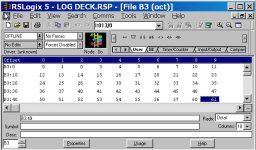Hi,
I have a system with 24 filters each with its own PLC5 on a DH+ network (actually 2 networks of 12). The filters are numbered 1 to 24 and the DH+ node address increment from 1 (1,2,3,4,5,6,7,10,11,12,13,14,15,16,17,20 etc).
I need to write some logic to convert the octal address (s2/0 to s2/5) to decimal. Ive found the formula on Wikipedia but thats a little bit beyond me. I kind of understand how to convert oct to dec, but im not sure how to do it in code. Can anyone offer assistance
I have a system with 24 filters each with its own PLC5 on a DH+ network (actually 2 networks of 12). The filters are numbered 1 to 24 and the DH+ node address increment from 1 (1,2,3,4,5,6,7,10,11,12,13,14,15,16,17,20 etc).
I need to write some logic to convert the octal address (s2/0 to s2/5) to decimal. Ive found the formula on Wikipedia but thats a little bit beyond me. I kind of understand how to convert oct to dec, but im not sure how to do it in code. Can anyone offer assistance






